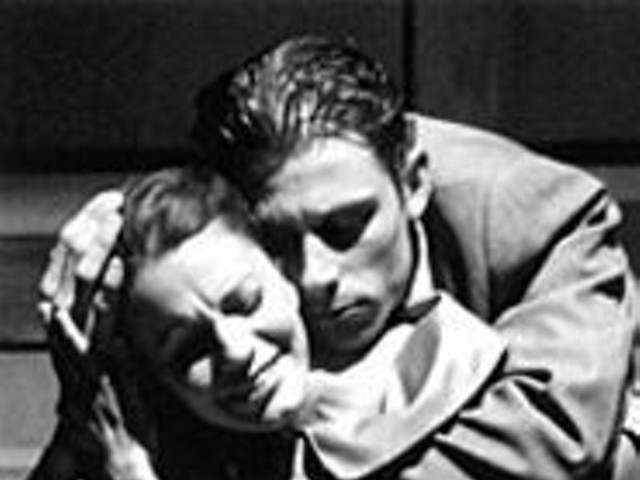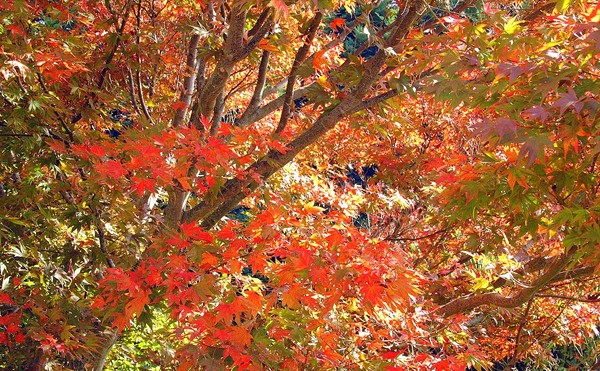These days, developments in digital imaging have caused observers to question the relationship between that medium and painting and to explore possibilities for abstraction and representation that might emerge from it.
Artists in two current shows take on these questions and allow for interesting reflection on the state of contemporary painting. Elliot Smith Contemporary Art is featuring new works by Ken Worley and Colleen Randall, and the Atrium Gallery celebrates its 15th anniversary with the exhibition Moving On, with paintings and digital prints by Christina McPhee and paintings by Alex Macdonald.
Worley is an abstract painter in the strictest sense: He abstracts from nature, transforming observed landscapes into symbols. There's something of Julian Opie's cartoonishness in Worley's flattened trees and removal of detail. There's also more than a little of Grant Wood's landscape style here, evident in Worley's perfectly rounded hills and condensed perspective. But for Wood's and Opie's detached irony, Worley substitutes an almost surrealist air of mystery. His landscapes consist mainly of trees and hills, but the shadows between them seem to harbor the unknowable. As in paintings by Giorgio de Chirico, whatever might be around the corner is infinitely more terrifying than what is actually represented.
Add to this Worley's quasi-pointillist technique with the oil stick, and the result is a group of landscapes with dazzling surface effects and an undercurrent of tension. Worley's paintings are suspended between abstract sign and deep psychological narrative. The regularity of the series -- 11 oil-stick landscapes on canvas, two oil-stick landscapes on terracotta plates, all in the same basic format, all titled "Rockwoods" -- lends them a decidedly minimalist quality. Worley, a well known St. Louis artist, is operating in some interesting terrain, indeed.
London artist Macdonald, likewise, has produced a group of paintings that feel minimalist in their reductive character and consistency. All but one of Macdonald's works featured at the Atrium are sprayed acrylic on canvas, around 53 by 37 inches. Each painting contains a field of blue so intense in color and even in distribution that it invites a comparison with Yves Klein's IKB paintings of the late 1950s. Macdonald's works, however, are more than fields of pure color. In each, the softened features of a human face merge with the color field even as they emerge from it. Stare at the canvas long enough, and the entire surface begins to pulsate.
Macdonald's "Blue Box Heads" could be images of Buddha -- they possess the tranquil softness associated with attainment of nirvana. There's tranquility, too, in the perfect surface attained by the spray brush. There are no gaps in the paint to bring us back to the vulnerability of the artist's hand. These works have the same airbrushed allure of custom-van paintings or Richard Estes' photorealist streetscapes. But the slick depiction of the Buddha-like heads pitches these works to an even higher state of artificial spirituality.
The final work in Macdonald's collection deserves some mention. "Pink Body" is an enamel painting on medium density fiberboard, quite a bit smaller than the "Blue Box Heads." The colors are definitely contemporary, but the obviously hand-painted flowers and the sinewy lines that frame the image recall Henri Matisse's decorative style. This work's expressiveness is in marked contrast to the colder, manufactured sensibility of the blue paintings.
McPhee's works, also on view at the Atrium, explore yet another kind of abstract sensibility. This collection consists of oil paintings, digital pigment prints and collages, most of which are derived from stills of a performance video that, unfortunately, is not on view in the gallery. In her prints and paintings, the colors are dark and saturated, and the forms vacillate between the architectonic and the cosmic -- structures are stable and then disintegrate, permeated by immaterial smoke and light.
These images replicate visual and aural perception in movement. Titles such as "Slipstream Freefall.1," "streak.5," "falconrush" and "soundgrass" suggest the rushing, noisy qualities of the pictures. They're like half-remembered dreams of flying through an unknown city -- one tumbles through these pieces as much as one views them.
The most intriguing aspect of McPhee's work is the exploration of abstract form in the digital and painted mediums. "Naxsign," a digital pigment print with drawing, shows something like a neon-lighted city street seen through the window of a moving car -- lights and structures are unnaturally stretched out and then abruptly cut off. "Slipstreamperseid.5," hanging nearby, appears to be an oil-on-canvas analog of the digital scene. These works together contemplate the points of intersection of painted and digital abstraction. Like Gerhard Richter's large-scale abstract works, McPhee's paintings contain the illusion of expressionist, haphazard markmaking. In reality, they are studied constructions of abstractions in paint that strike up a dialogue with their digital counterparts.
McPhee's works represent some advanced thinking into the relationship of painting to digital art, and imagery to abstraction, in contemporary art. In contrast, Randall, whose paintings are on view at Elliot Smith, admits to being firmly rooted in the tradition of the abstract sublime, and far from any attempt to destabilize that category. Randall's paintings, small in scale, boast layer upon layer and skein upon skein of palpable oil paint, sometimes mixed with other materials, such as ash or sand. The material accumulates until the surface resembles a craggy, eroded cliffside, toned with subtle hues.
These paintings employ abstraction as a corollary of psychological or metaphysical states. Many bear the title "Syncope" and suggest themselves as illustrations of the space between consciousness and unconsciousness. They are visual swoons, unabashedly emotional and expressionist, descending from a genealogy that reaches back through Mark Rothko and Jackson Pollock, to Caspar David Friedrich and Fredrick Church. Randall's paintings may be small, but they presume to represent the unlimited spaces of the psyche.
Where do Randall's works leave us in the consideration of painting and abstract imagery today? If nothing else, they remind us that tradition endures, and that there are still artists who consider themselves uncritically as the heirs of practices established centuries ago. Worley's work reflects a somewhat more critical engagement with his contemporaries and forebears in art history -- while continuing the use of a conventional medium. Macdonald achieves a level of artificial spirituality that enjoys a fascinating relationship to traditions of the spiritual in art. And Randall's works, perhaps the most rewarding of the group, encompass questions of the status of contemporary abstraction, and how it is informed by time-based media and digital art.
The range of issues these artists engage is certainly broad, but ultimately it only hints at some of the directions painters are taking today. And where else might painting take us in the new millennium? Stay tuned.





